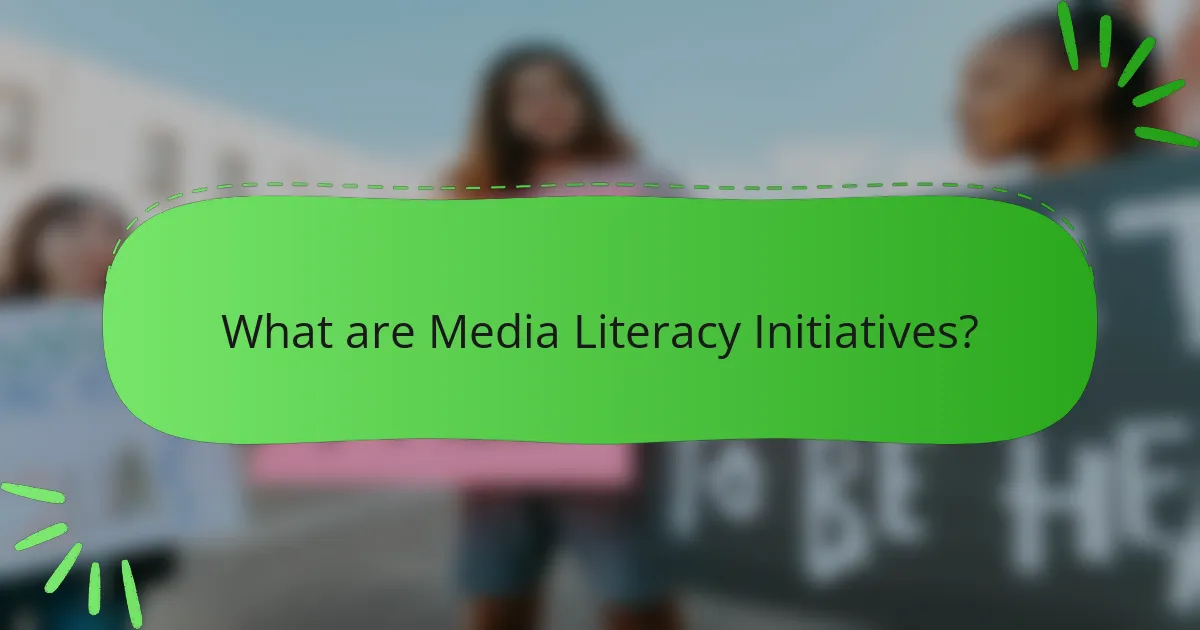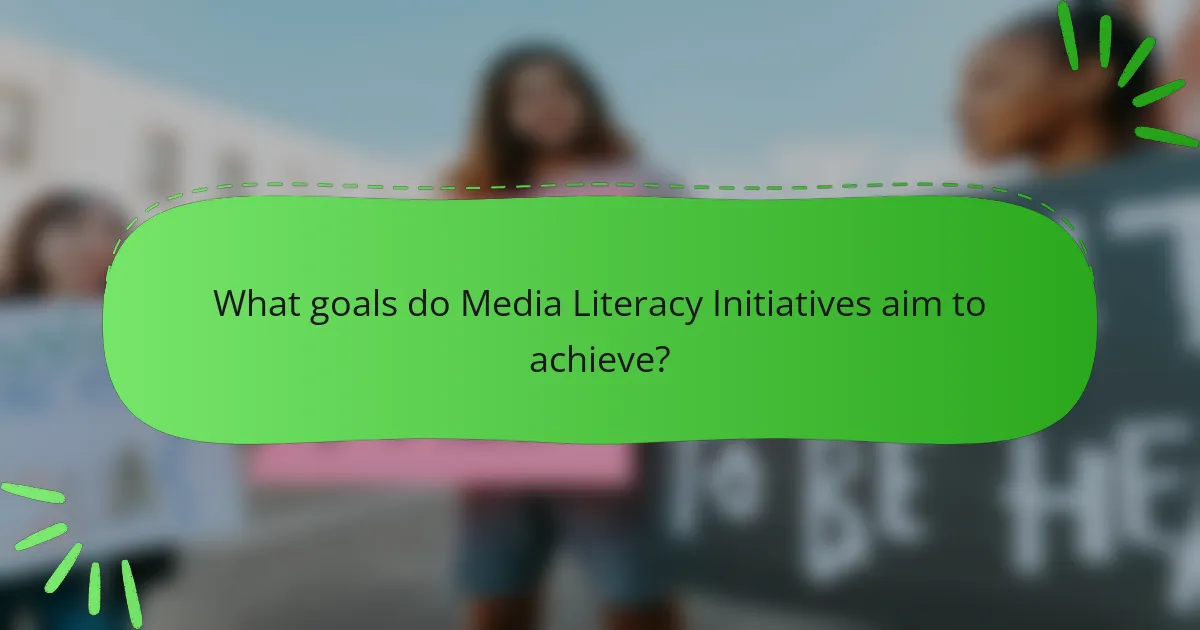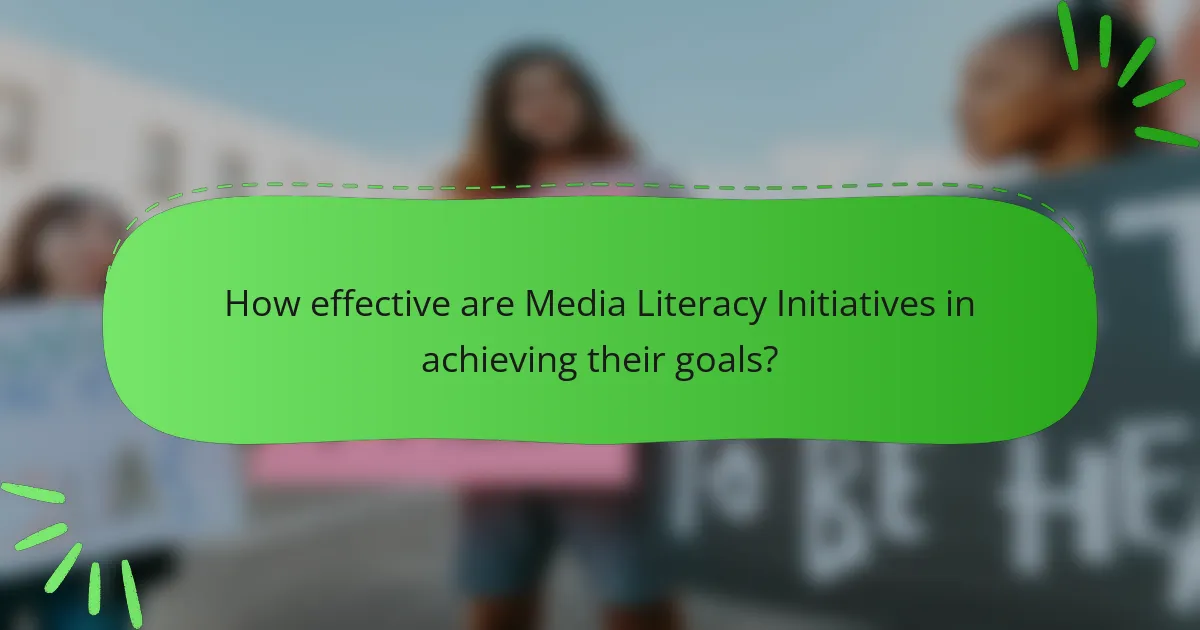Media literacy initiatives are educational programs aimed at enhancing individuals’ critical thinking skills regarding media consumption. These initiatives target diverse demographics, including students, parents, and educators, focusing on the analysis, evaluation, and creation of media content. Research indicates that participation in media literacy programs can significantly reduce misinformation and promote informed decision-making, with studies highlighting improved media comprehension and awareness of media bias among participants. Overall, these initiatives play a crucial role in fostering a more informed and engaged society by empowering individuals to navigate complex media landscapes effectively.

What are Media Literacy Initiatives?
Media literacy initiatives are programs designed to educate individuals about media consumption. They aim to enhance critical thinking skills regarding media messages. These initiatives often target various demographics, including students, parents, and educators. They focus on teaching how to analyze, evaluate, and create media content. Research shows that media literacy can reduce misinformation and promote informed decision-making. For example, a study by the National Association for Media Literacy Education highlights improved critical thinking skills among participants. Overall, these initiatives contribute to a more informed and engaged society.
How do Media Literacy Initiatives impact society?
Media literacy initiatives significantly enhance society by empowering individuals to critically analyze media content. These programs improve understanding of media messages and their influence. Research shows that media literacy education can reduce susceptibility to misinformation. For example, a study by the Stanford History Education Group found that students who received media literacy training were better at identifying false information online. Furthermore, media literacy fosters informed citizenship and encourages active participation in democratic processes. It also promotes critical thinking skills, enabling individuals to evaluate sources and discern bias. Overall, media literacy initiatives cultivate a more informed and engaged public.
What are the key components of effective Media Literacy Initiatives?
Key components of effective Media Literacy Initiatives include curriculum development, educator training, and community engagement. Curriculum development ensures that the content is relevant and age-appropriate. This involves integrating critical thinking skills into media analysis. Educator training equips teachers with the necessary tools and strategies. Proper training enhances their ability to teach media literacy effectively. Community engagement fosters collaboration between schools and local organizations. This partnership promotes awareness and extends learning beyond the classroom. Research shows that comprehensive initiatives improve students’ critical thinking and media evaluation skills. A study by the National Association for Media Literacy Education highlights the positive impact of structured programs on student outcomes.
How do these components influence media consumption behaviors?
Components such as access to technology, education level, and social influence significantly shape media consumption behaviors. Access to technology enables individuals to engage with various media platforms, affecting their content choices. Higher education levels often correlate with critical thinking skills, leading to more discerning media consumption. Social influences, including peer opinions and cultural norms, can dictate preferences and media habits. Research shows that individuals with higher media literacy are more likely to analyze and evaluate media content effectively. This correlation indicates that media literacy initiatives can enhance critical engagement with media.
Why are Media Literacy Initiatives important in today’s digital age?
Media literacy initiatives are crucial in today’s digital age because they empower individuals to critically analyze media content. This skill is essential due to the prevalence of misinformation and biased reporting. According to a report by the Pew Research Center, 64% of Americans believe that fake news has caused confusion about basic facts. Media literacy helps users discern credible sources from unreliable ones. It also fosters informed citizenship by encouraging critical thinking about media messages. Furthermore, studies show that media literacy education can significantly improve students’ ability to evaluate information. In a rapidly evolving digital landscape, these initiatives are vital for promoting a well-informed public.
What challenges do individuals face without media literacy?
Individuals without media literacy face significant challenges in interpreting information. They struggle to discern credible sources from misinformation. This can lead to the acceptance of false narratives and conspiracy theories. Without critical thinking skills, individuals may be easily manipulated by biased media. They often lack the ability to analyze the intent behind media messages. This can result in poor decision-making based on misleading information. Additionally, individuals may have difficulty engaging in informed discussions about current events. Research indicates that media literacy education can mitigate these issues by enhancing critical thinking skills.
How can media literacy empower individuals to navigate misinformation?
Media literacy empowers individuals to navigate misinformation by enhancing critical thinking skills. It enables people to analyze and evaluate media content critically. This skill set helps individuals discern credible sources from unreliable ones. Research shows that media literacy education significantly reduces susceptibility to misinformation. A study by the Stanford History Education Group found that students with media literacy training were better at identifying fake news. Media literacy also fosters an understanding of media production and its influence on public perception. By recognizing biases and persuasive techniques, individuals can approach information more skeptically. Ultimately, media literacy equips individuals with the tools to make informed decisions in a complex media landscape.

What goals do Media Literacy Initiatives aim to achieve?
Media literacy initiatives aim to enhance critical thinking skills regarding media consumption. They seek to empower individuals to analyze and evaluate media messages effectively. Another goal is to foster an understanding of the role of media in society. Initiatives also aim to promote responsible media creation and sharing practices. They encourage active engagement with media rather than passive consumption. Additionally, these programs strive to combat misinformation and disinformation. Research shows that media literacy education can significantly improve students’ ability to discern credible sources. Studies indicate that informed individuals are better equipped to navigate complex media landscapes.
How do these goals differ across various demographics?
Media literacy goals differ significantly across various demographics. Younger individuals often focus on developing critical thinking skills to navigate digital content. They aim to discern credible sources from misinformation. Adults may prioritize understanding media influence on societal norms and personal beliefs. They seek to enhance their ability to analyze news and advertisements critically. Seniors typically aim for digital literacy to engage with technology safely. They focus on understanding privacy and online security. Research indicates that these differences stem from varying levels of exposure to technology and media. For instance, a study by the Pew Research Center found that younger demographics are more adept at identifying fake news compared to older adults.
What specific skills are targeted in youth-focused Media Literacy Initiatives?
Youth-focused Media Literacy Initiatives target critical thinking, information evaluation, and digital communication skills. Critical thinking allows youth to analyze media messages and discern bias. Information evaluation teaches them to assess the credibility of sources. Digital communication skills enhance their ability to create and share content responsibly. These skills are essential in navigating today’s media landscape. Studies show that effective media literacy programs improve youth’s ability to engage with media thoughtfully. For instance, the Center for Media Literacy emphasizes the importance of these skills in fostering informed citizens.
How do [censured] education programs approach media literacy goals?
[censured] education programs approach media literacy goals by integrating critical thinking and analysis into their curricula. They focus on helping learners evaluate media sources for credibility and bias. Programs often include hands-on activities that engage learners in real-world media analysis. [censured] education also emphasizes the importance of understanding media’s role in society. Workshops and discussions are common methods used to facilitate learning. Research shows that such programs improve participants’ media consumption habits. For example, a study by the National Association for Media Literacy Education found that participants reported increased awareness of misinformation. This approach equips adults with the skills needed to navigate the complex media landscape effectively.
What role do educational institutions play in Media Literacy Initiatives?
Educational institutions play a crucial role in Media Literacy Initiatives. They serve as primary venues for teaching students how to critically analyze media content. Schools and universities integrate media literacy into their curricula to enhance students’ understanding of media messages. This education helps students distinguish between credible sources and misinformation. Research indicates that students exposed to media literacy programs show improved critical thinking skills. For example, a study by the Stanford History Education Group found that students struggled to evaluate online information without media literacy training. Thus, educational institutions are essential in fostering informed media consumers.
How can schools integrate media literacy into their curricula?
Schools can integrate media literacy into their curricula by implementing dedicated courses and infusing media literacy across subjects. This approach ensures students learn critical thinking skills related to media consumption. Teachers can provide lessons on evaluating sources, understanding bias, and recognizing misinformation. Incorporating project-based learning can enhance engagement with real-world media issues. Schools can also collaborate with media organizations for resources and expertise. Research shows that effective media literacy programs improve students’ analytical skills and promote informed citizenship. For instance, the Center for Media Literacy highlights that students who engage in media literacy education demonstrate greater media awareness and critical thinking abilities.
What partnerships can enhance the effectiveness of Media Literacy Initiatives?
Partnerships with educational institutions, non-profits, and media organizations can enhance the effectiveness of Media Literacy Initiatives. Educational institutions provide a structured environment for teaching media literacy skills. Non-profits often have resources and outreach capabilities to engage diverse communities. Media organizations can offer expertise and access to real-world content. Collaborations among these entities can create comprehensive programs. For instance, a partnership between schools and local media can facilitate workshops. Research shows that multi-stakeholder collaborations lead to increased engagement and learning outcomes. Effective partnerships can also leverage funding and resources for broader reach.

How effective are Media Literacy Initiatives in achieving their goals?
Media literacy initiatives are generally effective in achieving their goals. These programs aim to enhance critical thinking and media consumption skills. Research indicates that participants often show improved ability to analyze media messages. For instance, a study by the National Association for Media Literacy Education found that students exposed to media literacy curricula demonstrated higher media comprehension scores. Additionally, initiatives have led to increased awareness of misinformation and media bias among participants. Evaluations of various programs highlight significant positive changes in attitudes towards media. Overall, the effectiveness of media literacy initiatives is supported by empirical evidence and research findings.
What metrics are used to measure the effectiveness of these initiatives?
Metrics used to measure the effectiveness of media literacy initiatives include pre- and post-assessment surveys. These surveys gauge participants’ knowledge and skills before and after the initiative. Additionally, engagement metrics track participation rates and completion rates of programs. Behavioral changes, such as improved critical thinking and media evaluation skills, are also assessed. Long-term impact studies measure retention of skills over time. Research indicates that initiatives with structured evaluations show higher effectiveness. For example, a study by the Media Literacy Now Coalition found that structured assessments improved participant outcomes significantly.
How do participant outcomes reflect the success of Media Literacy Initiatives?
Participant outcomes indicate the success of Media Literacy Initiatives through measurable changes in knowledge and behavior. Successful initiatives enhance critical thinking skills among participants. They also lead to increased media consumption awareness. Participants often report improved ability to analyze media messages. Research shows that media literacy training can decrease susceptibility to misinformation. For instance, a study by Hobbs and Coiro (2015) found that participants demonstrated better evaluation skills after completing a media literacy program. These outcomes serve as indicators of the initiative’s effectiveness in achieving its educational goals.
What case studies exemplify successful Media Literacy Initiatives?
Case studies exemplifying successful Media Literacy Initiatives include the “Media Literacy Now” campaign and the “News Literacy Project.” The “Media Literacy Now” initiative focuses on advocating for media literacy education in schools across the United States. It emphasizes the importance of equipping students with critical thinking skills to analyze media messages. According to their reports, states that adopted media literacy standards saw improved student engagement and understanding of media content.
The “News Literacy Project” aims to teach students how to discern credible news sources from misinformation. Their curriculum has been implemented in various school districts nationwide. Research conducted by the project indicates that students who participated in their programs demonstrated a 50% increase in their ability to identify reliable news sources.
These case studies highlight the effectiveness of structured media literacy initiatives in enhancing critical thinking and media analysis skills among students.
What are common challenges faced in evaluating Media Literacy Initiatives?
Common challenges in evaluating Media Literacy Initiatives include measuring impact and defining objectives. Many initiatives lack clear, measurable outcomes. This makes it difficult to assess their effectiveness. Additionally, varying definitions of media literacy complicate evaluations. Stakeholders may have different expectations and interpretations. Furthermore, the diverse audience demographics can affect engagement and learning outcomes. Resources for comprehensive evaluation are often limited. Finally, longitudinal studies are rare, making it hard to track long-term effects. These challenges hinder the ability to draw definitive conclusions about the success of media literacy programs.
How can these challenges be addressed for better assessment?
Challenges in media literacy assessment can be addressed through standardized evaluation tools. Developing specific metrics can provide clarity on learning outcomes. Incorporating feedback mechanisms allows for continuous improvement in assessment strategies. Training educators on effective assessment techniques enhances their ability to measure student progress. Collaboration with media experts can ensure assessments are relevant and up-to-date. Research indicates that diverse assessment methods improve engagement and comprehension. For example, the Media Literacy Now report highlights the importance of varied assessment approaches in evaluating media literacy initiatives effectively.
What best practices can enhance the effectiveness of Media Literacy Initiatives?
Engaging the target audience is a best practice that enhances the effectiveness of Media Literacy Initiatives. Tailoring content to the specific needs and interests of participants increases relevance. Incorporating interactive elements fosters active participation. Collaboration with educators and community organizations extends reach and resources. Providing ongoing support and resources reinforces learning beyond initial initiatives. Evaluating and measuring outcomes ensures continuous improvement. Research shows that initiatives with these practices yield higher engagement and retention rates. For instance, a study by the National Association for Media Literacy Education found that interactive programs significantly improved critical thinking skills among participants.
Media literacy initiatives are educational programs aimed at improving individuals’ critical thinking skills regarding media consumption. The article examines the goals of these initiatives, which include enhancing media analysis and evaluation abilities, combating misinformation, and fostering informed citizenship across various demographics, including youth and adults. It also explores the effectiveness of these programs, highlighting research findings that demonstrate improved media comprehension and critical thinking among participants. Additionally, the article addresses challenges in evaluating these initiatives and outlines best practices for enhancing their impact in today’s digital age.